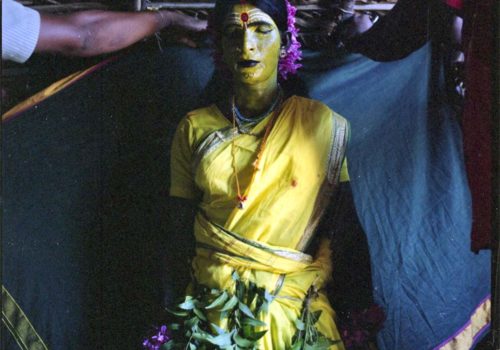I was invited to Devanapattinam, Tamil Nadu, India to photograph a celebration of the Mayanakollai festival. The festival, to celebrate the deity Angalamman, and was put on by a group of Kothis – male born people who take on the female sex role with men, and who often dress as women.
Working in India, where I lived for almost three years, I was always struggling to capture the extraordinary visual kaleidoscope of India without falling back on cliché or kitsch. On that score this project posed a particularly interesting problem. It was an exotic event – a colorful Hindu temple festival – put on by some of the most exoticized people in India, the transgendered/third sex/kothi community, which has been widely photographed and written about.
When we arrived and were welcomed immediately and enveloped into the scene. At first it didn’t seem like much was happening. We saw them preparing for the festival: stringing garlands on idols, getting dressed, arranging offerings. The most fascinating thing about spending time in this community, was how within the structure of religion, everything was embraced. At one point some of the performers were teased by a group of drunk boys, and though they were upset, they told us that they would have been far more vulnerable to taunts had they been “actual” women.
It was never entirely clear, even with a translator and very cooperative hosts, what was always happening. There was a undercurrent of surprise and mystery. Much of it was a matter of letting go and looking for a beautiful moment to unfold. So much was lost within the explanation of the origins of the festivals and the stories of the Hindu gods and goddesses. To try to both illustrate, but also find an unguarded or vulnerable moment in the midst of what felt very much like chaos. There was a goat sacrifice and an “Indian Dracula.” There was a simulated fight over the soul of a baby that involved the destruction of a huge effigy of a man constructed out of sand and placing flowers on the graves of the dead. That surreal scene provided a backdrop to a dressed up chase through the village cemetery at dusk. My goal during it all was to somehow absorb the exoticism of the event – while trying not to rely on or exploit that exoticism.
The men dressing like women in the context of a religious festival (where that would historically be done), but in this case the men who are dressing up like female goddesses are doing so deliberately in order to express their own desires to dress like women and take up the female role in sex. I also felt concerned about showing the exoticism of this community without any other context. Because “kothis” are often treated as other, or forced to be outsiders, it became even more important to try to show the nuances. The idea was to make pictures beautiful and quiet, while also showing some humanity in the people.
Candace Feit
I have been working as a photojournalist since 2004.
In the past several years I have moved beyond stories to a deeper narrative of people and their relationship to their environments and the objects within them.
For these images I choose to use 120mm film – as a way to slow down the constant shutter click and more deliberately compose my images. This also helps me interact differently with my subject.
My work has appeared in New York Times, The Globe and Mail, The Los Angeles Times, The Chicago Tribune, National Geographic Magazine, U.S. News and World Report, Time Magazine and dozens of other publications.
I currently live in Johannesburg, South Africa. Available for assignments worldwide.
















